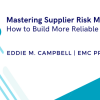A multisourcing contracting strategy is designed to break entrenched relationships with key technology providers and create a suitably tensioned environment where the business can access a wider range of service providers offering greater innovation and price competition, but without compromise to continuity of service or service integration. Significantly, it recognises at the outset that different providers will be involved in the end-to-end services, and addresses both the challenges and opportunities this presents.
The introduction of this model certainly creates the desired competitive environment and avoids the pitfalls associated with poor delivery of a single provider. However it also brings with it additional issues and complexities which must be successfully navigated and managed.
- Designing the right sourcing strategy: it will be important for the sourcing strategy to provide access to the right suppliers, in a streamlined manner, without compromising either value for money or continuity of supply.
- Managing supplier interface and collaboration: working in a multi-supplier environment involves an incremental increase in the points of interface, greatly increasing the risk of a supplier disclaiming responsibility for a failure and effectively transferring risk back to the customer.
- Managing transition and incumbency risk: where incumbent service providers are delivering many of the core services that are to be outsourced, it will be essential to have in place a workable transition plan to protect continuity of supply (i.e. assurance that there will be no break in service). This is an area that can be overlooked and if not managed from early in the process can undermine the viability of the entire competitive procurement. Equally, the customer will want to maintain a level playing field where incumbents are neither unfairly advantaged nor disadvantaged and will work with the customer to ensure a smooth transition.
Delivering success
In our experience, key to ensuring end-to-end integration is the creation of an environment where all suppliers are working together towards a common goal, and are appropriately rewarded for doing so. The following factors will need to be considered:
- Incentivisation: developing a cross-supplier model which rewards the “correct” collaborative behaviours. The most successful models are those which give rise to a tangible financial benefit; for instance, the setting aside of a percentage of the charges into a collective pot (which can potentially be “match funded” by the customer) with monies paid out to those suppliers who implement innovations or demonstrate exceptional collaborative behaviours, including demonstrating a “fix first, discuss later” mentality.
This more innovative approach can be supplemented by traditional models such as end to end/ cross-supplier service levels and accompanying service credit regimes. - Collaboration: a clear articulation of the desired collaborative behaviours (such as openness, honesty, transparency) linked to the incentivisation model and governed by multi-supplier collaboration agreements.
- Dependencies: defining the service boundaries or “handshakes” between each supplier and the customer, which are clearly articulated and contractually binding.
- SIAM: clearly scoping out the service integration role ensuring appropriate interfaces with other providers and empowering the service integrator to proactively and successfully manage the multisourcing structure.
- Pricing models: the deployment of utility/transaction based pricing, which allows charges to be passed through to the business in line with actual demand and thereby incentivise efficiency savings from the internal user (for example by giving a direct cost saving if volumes of print are reduced).
- Liabilities: managing cross-contract delivery risk, compensation provisions and limitation on liability clauses.
- Governance: establishing effective multi-party escalation and dispute resolution procedures.
Over a number of years we have acted for some of the largest government departments, public authorities and private sector clients in the development and implementation of successful multi-sourcing models, and have so become conversant with both the “must haves” and “must avoids”.
Overall, multisourcing can often arise more by accident than by design and so represent both a lost opportunity and a service delivery risk. In contrast, a well-crafted procurement and contract strategy can engender both collaboration and innovation.










